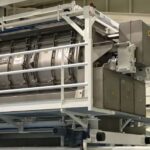While it has grown to be an almost $500 trillion global market, dairy farming is an age-old practice that dates back thousands of years. But Dr. Bethany Deshpande, CEO of the Canadian agricultural technology company SomaDetect, saw an opportunity to innovate.
“With more than 40,000 dairy farms in North America, these busy farmers have a certain approach to farm management, but it isn’t always efficient. SomaDetect empowers farms with data-driven insights they can use in the day-to-day work of caring for their herds and producing higher quality products,” highlights Deshpande.
Using a two-part system, SomaDetect levels up the traditional dairy farm with in-line optical sensors and deep-learning algorithms to provide farmers with valuable insights into herd health, milk quality, and reproduction. The company’s technology is reshaping how farmers care for their cows and manage their operations.
A Father-Daughter Project Turned Tech Start-up
SomaDetect’s patented technology was first conceptualized by Deshpande’s biophysicist father when he discovered the unique properties of milk in his research on light scattering. But it was Deshpande herself who identified the opportunity to apply the technology to dairy farming after continued research on everyday dairy products with her father.
Deshpande explains, “We looked carefully at somatic cells, which are any cells in a living organism that aren’t reproductive. Somatic cells in raw milk are there as part of an immune response, and so for individual cows, these cells can be used as a marker for disease and milk quality.”
SomaDetect’s in-line technology monitors a cow’s somatic cell count (SCC), flagging any elevated levels or other abnormalities. For example, a high somatic cell count could be a symptom of an udder infection. Diseases such as this can cause a cow to produce less milk and require costly veterinary care.
Deshpande followed in her father’s footsteps as a researcher and changemaker, graduating with her doctorate in Biology from Université Laval, a top-tier Canadian university based in Québec. And while she saw the potential, Deshpande did not have an intricate understanding of the dairy industry.
Real-World Research and Testing, Powered by Milk
“We spent a lot of time with farmers, learning about their processes, meeting the cows, understanding what matters most to them, and seeing the farms up close and personal. I’m so thankful for those early conversations because the insight moved us forward,” Deshpande says. That collaboration and primary research turned the concept of SomaDetect technology into a real-world use case.
Since its founding in 2016, more than 15 farms have incorporated SomaDetect’s optical sensor and AI-powered technology in their day-to-day operation. The monitoring system fits into existing milking lines, where it uses light scattering technology and computer vision to monitor a cow’s health indicators. SomaDetect’s series of deep-learning models analyze and pinpoint anomalies within that monitoring data, such as a spike in somatic cells.
And the data collected from those farms already show promising results. A recent study shows that farms using SomaDetect’s SCC algorithm have reduced antibiotic usage by 50 percent on average. Another study reports that bulk tank milk quality improved by 50 percent. While machine learning doesn’t pair with a glass of milk as classically as a chocolate chip cookie, leveraging artificial intelligence can help farmers carefully monitor each cow at every milking.
The technology also provides insights into a herd’s reproductive health. SomaDetect can help farmers pinpoint a cow’s open status—whether or not an animal is pregnant—as early as 18 days after breeding.This game-changing information helps herd managers and reproductive technicians make breeding decisions that have massive long-term implications on the genetics and performance of the herd.
Dr. Roger Saltman, an industry expert and major advisor to SomaDetect, expressed his excitement about this capability, stating, ” Realizing that the economic value in dairy cattle reproduction is optimized when we are able to get cows pregnant as soon after the Voluntary Wait Period as possible, I have been hoping to find a solution to identify open cows. SomaDetect’s recently developed product, SomaRECON, finally offers the ability to identify cows at high risk of being open at 18 Days Carrying Calf.”
Reshaping the Future of Dairy Farming
But rumors of SomaDetect’s innovation have spread outside the dairy industry. The company was named one of the Canadian Innovation Exchange’s top 20 brands in 2017 and selected as the Grand Prize winner in 43North’s $1M pitch competition in 2018. And more recently, SomaDetect was recognized as the winner of the 2023 Digital Agriculture Summit Startup Showcase, solidifying its position as a leading innovator in the field.
According to Deshpande, harnessing real-time milk insight can help reshape dairy farming. “Better data helps farmers to make informed decisions. It produces better milk for consumers. And, of course, it offers a better quality of life for the hardworking cows making that milk,” she says. The comprehensive visibility provided by SomaDetect’s AI-powered platform empowers farmers to optimize their operations, improve animal welfare, and contribute to a more sustainable dairy supply chain.
Currently, the SomaDetect team has 23 employees with headquarters in Canada and New York State. The team continues to work towards its vision of a more efficient and sustainable dairy industry. Learn more about how SomaDetect’s technology is changing how North America approaches dairy farming at somadetect.com.

















